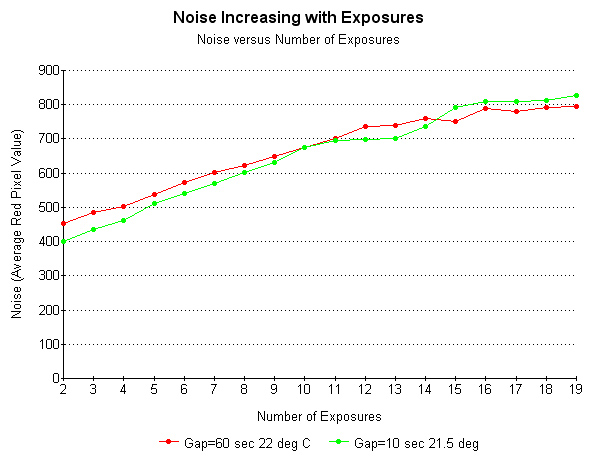Back to Astrophotography
CHIP HEATING EXPERIMENT (Part 3)
Back to Part 1 Part 2 ......
Part 4 Part 5
This is part 3 of an investigation to find out the best interval to put
between sub-exposures (subs) in order to minimise noise. The result shows that the
camera's CMOS chip gets gradually noisier with each photo taken.
Read part 1 and the method for the experiment here.
Interpreting the Result
a) The noise increases with each new sub - even if you put a 10 second gap
between subs;
b) Comparing Part 3 of the experiment with Part 2 we see that subs with a
60 second interval between them are just as noisy as subs taken with a 10 second interval;
c) Comparing Part 3 of the experiment with Part 2 there appears to be
little or no benefit in waiting more than 10 seconds between subs. See the graph.
Despite the 10 second gap between subs the noise keeps increasing.

EQUIPMENT
Canon EOS 350D (unmodified) In-camera Noise Reduction Off; ISO 1600.
A digital thermometer was used to measure air temperature
RAW DATA
| Sub |
Exposure
secs |
Interval
Seconds |
Temp
Deg C |
Noise**
(Pixel Value) |
Std Dev
(Pixels) |
Total Noise
(Pixel values) |
Reference
Elapse Time |
| 1 |
120 |
10 |
21.5 |
389 |
598 |
3.127e9 |
00:00 |
| 2 |
119 |
10 |
21.5 |
415 |
647 |
3.340e9 |
02:10 |
| 3 |
120 |
10 |
21.5 |
393 |
691 |
3.160e9 |
04:20 |
| 4 |
119 |
10 |
21.5 |
494 |
769 |
3.974e9 |
06:30 |
| 5 |
119 |
10 |
21.5 |
498 |
819 |
4.005e9 |
08:40 |
| 6 |
120 |
10 |
21.5 |
543 |
876 |
4.368e9 |
10:50 |
| 7 |
119 |
10 |
21.5 |
578 |
925 |
4.645e9 |
13:00 |
| 8 |
120 |
10 |
21.5 |
586 |
972 |
4.707e9 |
15:10 |
| 9 |
119 |
10 |
21.5 |
638 |
1021 |
5.132e9 |
17:20 |
| 10 |
120 |
10 |
21.5 |
666 |
1067 |
5.350e9 |
19:30 |
| 11 |
120 |
10 |
21.5 |
718 |
1114 |
5.779e9 |
21:40 |
| 12 |
120 |
10 |
21.5 |
703 |
1139 |
5.648e9 |
23:50 |
| 13 |
120 |
10 |
21.5 |
678 |
1163 |
5.447e9 |
26:00 |
| 14 |
120 |
10 |
21.5 |
725 |
1201 |
5.830e9 |
28:10 |
| 15 |
119 |
10 |
21.5 |
807 |
1244 |
6.487e9 |
30:20 |
| 16 |
130 (Oops) |
10 |
21.5 |
842 |
1375 |
6.770e9 |
32:30 |
| 17 |
119 |
15++ |
21.5 |
779 |
1290 |
6.266e9 |
35:00 |
| 18 |
119 |
10 |
21.5 |
810 |
1320 |
6.514e9 |
37:10 |
| 19 |
119 |
10 |
21.5 |
848 |
1351 |
6.815e9 |
39:20 |
| 20 |
120 |
10 |
21.5 |
827 |
1367 |
6.655e9 |
41:30 |
| 21 |
120 |
10 |
21.5 |
881 |
1399 |
7.086e9 |
43:40 |
| 22 |
120 |
10 |
21.5 |
909 |
1425 |
7.306e9 |
45:50 |
| 23 |
119 |
10 |
21.5 |
862 |
1433 |
6.931e9 |
48:00 |
| 24 |
119 |
10 |
21.5 |
959 |
1470 |
7.712e9 |
50:10 |
| 25 |
119 |
10 |
21.5 |
965 |
1489 |
7.758e9 |
52:20 |
| 26 |
120 |
10 |
21.5 |
888 |
1488 |
7.142e9 |
54:30 |
** These are dark frames so the average value of Red pixels is used here
in the table as a measure of noise. Noise is as measured in MaxDSLR using Info
dialog set to Area.
Go to Part 1 Part 2 Part 4
Part 5
Back to Astrophotography
|

